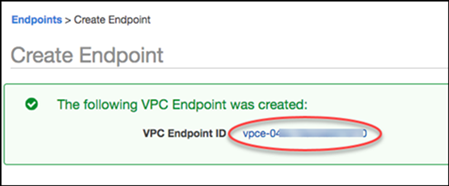Creating an Amazon VPC endpoint for the Amazon RDS Data API (AWS PrivateLink)
Amazon VPC enables you to launch AWS resources, such as Aurora DB clusters and applications, into a virtual private cloud (VPC). AWS PrivateLink provides private connectivity between VPCs and AWS services with high security on the Amazon network. Using AWS PrivateLink, you can create Amazon VPC endpoints, which enable you to connect to services across different accounts and VPCs based on Amazon VPC. For more information about AWS PrivateLink, see VPC Endpoint Services (AWS PrivateLink) in the Amazon Virtual Private Cloud User Guide.
You can call RDS Data API (Data API) with Amazon VPC endpoints. Using an Amazon VPC endpoint keeps traffic between applications in your Amazon VPC and Data API in the AWS network, without using public IP addresses. Amazon VPC endpoints can help you meet compliance and regulatory requirements related to limiting public internet connectivity. For example, if you use an Amazon VPC endpoint, you can keep traffic between an application running on an Amazon EC2 instance and Data API in the VPCs that contain them.
After you create the Amazon VPC endpoint, you can start using it without making any code or configuration changes in your application.
To create an Amazon VPC endpoint for Data API
Sign in to the AWS Management Console and open the Amazon VPC console at https://console.aws.amazon.com/vpc/
. -
Choose Endpoints, and then choose Create Endpoint.
-
On the Create Endpoint page, for Service category, choose AWS services. For Service Name, choose rds-data.

-
For VPC, choose the VPC to create the endpoint in.
Choose the VPC that contains the application that makes Data API calls.
-
For Subnets, choose the subnet for each Availability Zone (AZ) used by the AWS service that is running your application.

To create an Amazon VPC endpoint, specify the private IP address range in which the endpoint will be accessible. To do this, choose the subnet for each Availability Zone. Doing so restricts the VPC endpoint to the private IP address range specific to each Availability Zone and also creates an Amazon VPC endpoint in each Availability Zone.
-
For Enable DNS name, select Enable for this endpoint.

Private DNS resolves the standard Data API DNS hostname (
https://rds-data.) to the private IP addresses associated with the DNS hostname specific to your Amazon VPC endpoint. As a result, you can access the Data API VPC endpoint using the AWS CLI or AWS SDKs without making any code or configuration changes to update Data API's endpoint URL.region.amazonaws.com -
For Security group, choose a security group to associate with the Amazon VPC endpoint.
Choose the security group that allows access to the AWS service that is running your application. For example, if an Amazon EC2 instance is running your application, choose the security group that allows access to the Amazon EC2 instance. The security group enables you to control the traffic to the Amazon VPC endpoint from resources in your VPC.
-
For Policy, choose Full Access to allow anyone inside the Amazon VPC to access the Data API through this endpoint. Or choose Custom to specify a policy that limits access.
If you choose Custom, enter the policy in the policy creation tool.
-
Choose Create endpoint.
After the endpoint is created, choose the link in the AWS Management Console to view the endpoint details.

The endpoint Details tab shows the DNS hostnames that were generated while creating the Amazon VPC endpoint.

You can use the standard endpoint
(rds-data.) or
one of the VPC-specific endpoints to call the Data API within the Amazon VPC. The
standard Data API endpoint automatically routes to the Amazon VPC endpoint. This routing
occurs because the Private DNS hostname was enabled when the Amazon VPC endpoint was
created.region.amazonaws.com
When you use an Amazon VPC endpoint in a Data API call, all traffic between your application and Data API remains in the Amazon VPCs that contain them. You can use an Amazon VPC endpoint for any type of Data API call. For information about calling Data API, see Calling the Amazon RDS Data API.